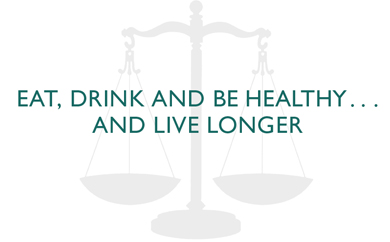EAT, DRINK AND BE HEALTHY . . . AND LIVE LONGER
by HARVEY FINKEL, MD
A QUESTION OCCURRED to me recently during a discussion of a related subject with colleagues of the International Scientific Forum on Alcohol Research. How do we know that the healthfulness of alcohol is enhanced by drinking during meals, often almost assumed as a given? What is the scientific support? Turns out, it is abundant. My fellow discussants, experts all, generously showered me with references from the scientific medical literature, some reporting their own research.
To establish the premise that moderate drinking promotes health and longevity, the minimally edited words of international authority Professor R. Curtis Ellison put it as well as any – true, terse and trenchant: Scientific data continue to support the premise that small to moderate amounts of alcohol on a regular basis are consistent with a “healthy lifestyle”. Binge drinking to intoxication is associated with adverse health effects – for the individual and for society. The most important mechanisms appear to be improvements in blood lipids and in glucose metabolism, a reduction in clotting tendency, beneficial effects on vascular endothelium, and decreased inflammation.
The relationship between drinking and health is expressed by the now-iconic J-shaped curve, which illustrates that moderate drinkers live healthier and longer than abstainers, and that heavy drinkers, the least healthy, die soonest.
Serge Renaud, a pioneer in this field, contended that consumption of moderate quantities of alcohol with meals made the difference – that was the French Paradox revealed by his research, and massively disseminated on the television program “6O Minutes” in 1991. [The French Paradox is the observation that the French, burdened by a host of unhealthy – but enjoyable – habits, suffer far fewer heart attacks and strokes than exercising, dieting, non-smoking Americans.] The rest of this essay is devoted to mechanisms.
Both epidemiological studies and laboratory experiments provide ample evidence that the polyphenolic antioxidants of wine, especially red wine, consumed with meals attenuates one of the risks increased by eating – postprandial oxidative stress. This physiologic stress following meals leads to oxidative damage by higher levels of blood fats and sugar, in turn resulting in cardiovascular disease, diabetes and obesity. Wine’s polyphenolics and alcohol also improve the health of the vascular endothelium, the vital inner lining of blood vessels, and retard the toxic oxidation of blood fats.
Drinking with meals gives other beneficial effects on blood fats, on the clotting complex, on insulin levels. Eating while drinking leads to slower and lower peaks of blood alcohol and faster elimination of alcohol. Mealtime moderate wine consumption has been shown to reduce the sensitivity of blood platelets, thereby lessening the postprandial risk of dangerous clots. Blood pressure rises undesirably from drinking outside of meals in contrast to mealtime drinking. Wine is less associated with elevation of blood pressure than beer, which is less noxious in this respect than liquor. Mealtime drinkers, especially of wine, are at reduced risk of heart attack. One caution in interpreting epidemiological, but not laboratory, studies: mealtime drinking and drinking outside meals may be markers of differing lifestyles, one healthier than the other.
Our take-home lesson today is that regular, moderate, mealtime drinking, especially of wine, is healthful. Binge drinking outside of meals is a potentially lethal practice.


